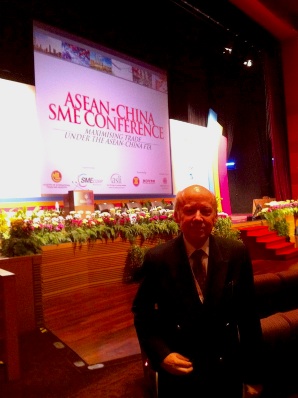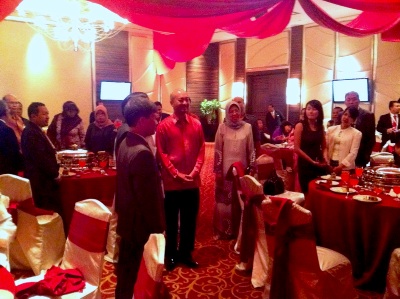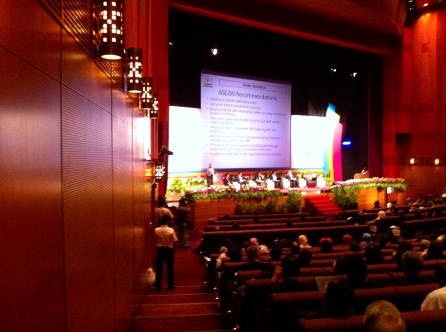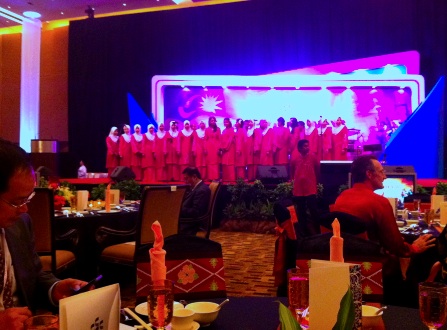
ASEAN-CHINA SME CONFERENCE
“MAXIMIZING TRADE UNDER THE ASEAN-CHINA FTA”
  From June 8-9, 2011 I attended the Asean-China SME Conference in Kuala Lumpur Malaysia as an invited speaker. The conference, which was co-organized by the Asian Strategy & Leadership Institute (ASLI) and the SME Corporation under the Ministry of International Trade and Industry of Malaysia was held to discuss how to maximize trade under the ASEAN-China FTA with a particular focus on how SMEs could best benefit.   The ASEAN-China FTA I believe does not get the focus in the West that is deserves. I write this because I believe the agreement is fundamentally changing trading relationships and acting to intertwine ASEAN-China trade in ways that will make ASEAN more interconnected and linked to China than ever before. These interconnections have business, economic, trade and strategic consequences that will change the future of businesses, trading, sourcing and supply operations and ultimately how these countries respond to each other. I also believe it opens up opportunities for US and European companies who have factories in ASEAN that many companies are not now noting or properly exploiting. Finally, it is leading to funds to help promote and increase trade between ASEAN and China that I believe many SMEs should be seeking to increase their sales and development. Is it perfect, frankly "no" and China still is exporting more to most of the ASEAN countries than it is importing but these deficiencies can be corrected or at least improved and I feel the Chinese government is moving to work on these issues.    The ASEAN-China agreement was a landmark for ASEAN as it was its first external FTA agreed to by ASEAN and has become a broad bridge of cooperation for the entire region. The agreement was agreed to in late 2004 and went into force in July, 2005. Since that time, the agreement has been further broadened. In July 2007, an agreement was signed on the liberalization of trade in services between China and ASEAN. A further agreement on investments is still under negotiations. As of 2010, the ASEAN 6 (Brunei, Indonesia, Malaysia, the Philippines, Singapore and Thailand) have eliminated tarrifs on 90% of their products. The remaining ASEAN countries (Cambodia, Laos, Myanmar and Vietnam) have till 2015 to meet this goal. Because of the agreement and because of political will on both sides trade between ASEAN and China has grown markedly under the agreement. China is now ASEAN’s biggest trading partner and ASEAN is China’s fourth. Further, trade is growing at a very fast rate between the two. In 2010, bilateral trade volume between ASEAN and China increased by 38 percent and will likely have a further substantial increase in 2011.
A further presentation on the importance of understanding standards, rules and regulations rounded out the morning presentations and included some very good updates on the Chinese economy which is currently going through many changes in focus plus examples on how Malaysian companies have made the most of the opportunities in China for their SMEs.
Later in the afternoon of the first day, we heard from a really top-notch panel on the subject of e-commerce and its effects and potential for further extending trade between ASEAN and China. E-commerce is growing rapidly between ASEAN and China and the Chinese government is supporting several initiatives to assist SMEs to better market and connect with Chinese companies. That evening we were hosted to a stunning cultural extravaganza by the organizers, which included both folk and modern elements. The next day, many of us visited the SME Innovation Showcase trade fair also in the Kuala Lumpur Convention Centre that included booths for SME companies, trade associations and other groups from throughout the region. The second days presentation were equally strong in the range of speakers and the expertise of the moderators. The first presentation was on the Logistics and the Value Chain System and focused on how SME’s could best profit in this sector. This was followed by a session on trade finance, which included banking representatives from most of the larger Malaysian banks plus also a Thai bank which is making great strides in terms of promoting Thai-China business. In the afternoon, an expanded panel focused on the issue “The Way Forward: Maximizing Growth for SMEs in the China-ASEAN Economies” which helped all of us to consider how things would change and where the opportunities and challenges existed.
The path is set and ASEAN and China are already well on the way to closer and more interlinked relations. U.S. and European business need to not get left at the station and all companies should spend increased attention to the growing middle class in ASEAN and China and to how best to optimize their prospects in not only China but in a rapidly growing ASEAN. About the Author: Christopher W. Runckel, a former senior US diplomat who served in many counties in Asia, is a graduate of the University of Oregon and Lewis and Clark Law School. He served as Deputy General Counsel of President Gerald Ford’s Presidential Clemency Board. Mr. Runckel is the principal and founder of Runckel & Associates, a Portland, Oregon based consulting company that assists businesses expand business opportunities in Asia. (www.business-in-asia.com) Until April of 1999, Mr. Runckel was Minister-Counselor of the US Embassy in Beijing, China. Mr. Runckel lived and worked in Thailand for over six years. He was the first permanently assigned U.S. diplomat to return to Vietnam after the Vietnam War. In 1997, he was awarded the U.S. Department of States highest award for service, the Distinguished Honor Award, for his contribution to improving U.S.-Vietnam relations. |



